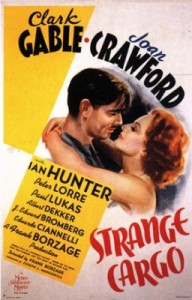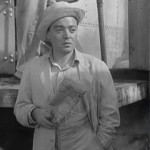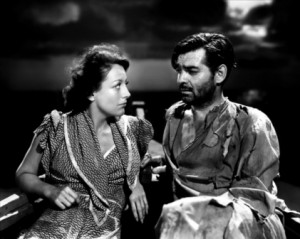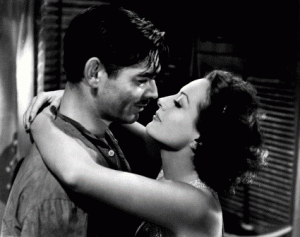 Men deep in Guiana, imprisoned in the harshest of prisons, presumably the infamous Devil’s Island. This initial location is never expressly identified, and in truth it probably matters not in the end result which is 1940’s Strange Cargo.
Men deep in Guiana, imprisoned in the harshest of prisons, presumably the infamous Devil’s Island. This initial location is never expressly identified, and in truth it probably matters not in the end result which is 1940’s Strange Cargo.
1940 must have been a pretty heady year for Hollywood, coming off what was doubtless perhaps the best year in cinematic history, 1939. Surely the expectations for 1940 were high. And there is not overwhelming reason why I dragged out Strange Cargo to watch over the Thanksgiving holiday.
It sports a tremendous cast, including Clark Gable (fresh off his Gone with the Wind success), Joan Crawford, Ian Hunter, Peter Lorre, and Paul Lukas. Stalwart director Frank Borzage, with over a hundred eventual directorial credits to his name- and the first Academy Award for Best Director, helms the picture, and does a admirable job with some rather unique material.
Of the above mentioned cast, all but Lorre play assorted convicts who ultimately attempt their escape. None of them are indifferent criminals decrying their innocence, rather for the most part their guilt is accepted. Gable is Verne, a thief. Crawford is Julie, who is most probably a prostitute, although this is never explicitly said. Lukas is a man who has murdered by poison numerous wives.
The night before they make their break a new prisoner, Cambreau- played by Ian Hunter, appears seemingly from nowhere. The others seem not to know who he is and his crimes are never really explained. He buys his way into the escape.
 Just to complete the cast I called out above, Peter Lorre is masterfully slimy as Monsieur Pig, a swarthy greasy little man who would obviously sell his own mother for a quarter. He helps the prisoners a bit, but only because Julie (Crawford) is among them. It is hard to tell which is greater, his yearnings for financial gain or those for Julie herself.
Just to complete the cast I called out above, Peter Lorre is masterfully slimy as Monsieur Pig, a swarthy greasy little man who would obviously sell his own mother for a quarter. He helps the prisoners a bit, but only because Julie (Crawford) is among them. It is hard to tell which is greater, his yearnings for financial gain or those for Julie herself.
Via many nefarious means our group of beleaguered souls makes their way to the beach and a waiting boat by which to make their escape to the mainland, which a few hardy survivors finally reach at journey’s end. Along the way Cambreau become’s completely Christ-like, finding the band food when hungry, and bringing them peace as the weaker ones slowly succumb to starvation.
 Much of the film feels a bit like Papillon, and still more feels a bit like Lifeboat, as much of the action happens on the boat. Without overkill, the spirituality of the film becomes strongest while at sea. It is unsurprising that the one prisoner who shows no impact from Cambreau is the murderer and atheist Hessler, played by Paul Lukas. Hessler is often downright condescending in his speech to Cambreau and as they talk they are the ones who agree they will never meet again after the ordeal of the escape, in a clear allusion to the afterlife, of lack thereof, depending on your fancy.
Much of the film feels a bit like Papillon, and still more feels a bit like Lifeboat, as much of the action happens on the boat. Without overkill, the spirituality of the film becomes strongest while at sea. It is unsurprising that the one prisoner who shows no impact from Cambreau is the murderer and atheist Hessler, played by Paul Lukas. Hessler is often downright condescending in his speech to Cambreau and as they talk they are the ones who agree they will never meet again after the ordeal of the escape, in a clear allusion to the afterlife, of lack thereof, depending on your fancy.
Strange Cargo is an odd film in that, although surely a product of the studio system- who were not especially known for taking chances- it does in fact take several. Some of the scriptural readings in the film were taking as blasphemy at the time, which resulted in somewhat reduced bookings for the picture at the time of release. Perhaps it takes a few too many chances, and for my money never quite realizes what it wants to be. It starts as a gritty prison escape film, then a symbolic theme of religious reawakening, with the final gasp of justice as Verne (Gable) returns to prison to serve out his sentence before marrying Julie.
 There is the obligatory romance as well between our two leads. Crawford and Gable are paired here in their eighth and final pairing. It was the end of one of the most famous of all early on-screen duos. Crawford as always for her pairings with Gable, receives top billing although it is really Gable’s picture.
There is the obligatory romance as well between our two leads. Crawford and Gable are paired here in their eighth and final pairing. It was the end of one of the most famous of all early on-screen duos. Crawford as always for her pairings with Gable, receives top billing although it is really Gable’s picture.
As I mentioned earlier, Gable was fresh off GWTW and at his peak. Crawford, on the other hand, was on a bit of a slide in her career. Personally I found Lukas’ performance the strongest, although all are very good. Lorre, although performing well, seems to have a completely irrelevant character. I found him a bit of a distraction from the remainder of the film.
Strange Cargo hits TCM with some frequency and is available on DVD, but only as part of The Joan Crawford Collection, Volume 2. It’s the strongest of the other four films included- those being A Woman’s Face, Flamingo Road, Sadie McKee, and Torch Song. The film looks pretty good in this release, though no frame by frame restoration was utilized.
Strange Cargo is a good film, but not a great one. Perhaps look on it as a precursor of some of the films later which used the same themes but perhaps in different ways.